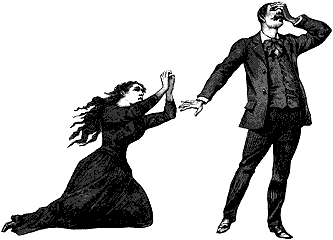Remember in Victorian Melodrama, all emotion is externalized. There is no such thing as inner psychological depth!
Generally, this means “Over the Top” in every way. Here are some techniques which help create this effect
- Slower, clearer delivery of lines with huge projection. Remember Victorian Theatres were huge and there were no microphones.
- Play everything to the audience, even if you are supposed to be talking to another character on stage!
- Indicate whom you are talking to by looking sideways at them and holding your hand out towards.
- Address the audience directly whenever the script will allow you to do so.
- The Pose: Invent poses of shock, horror, love, evil, intent, cruelty, desire, dilemma, forgiveness, begging forgiveness, etc. A pose should last at least three seconds and should be clearly visible from fifty meters.
- The working yourself up to the pose: lasts two to three seconds --let's see you get there!
- The Gasp - very loud expressing a range of emotions. Often accompanied by a pose.
- The Swoon - often preceded by lines such as "Alas! I can hardly bear it." The swoon should be graceful and provision should be made for someone to catch you.
- The long walk downstage/upstage/across the stage when hatching a plan or in a dilemma.
- The Pacing- to and fro across the stage when hatching a plan or in a dilemma. Move before you speak so that the audience can track who is speaking.
- The Tableau (freeze frame)- the still picture made up of a number of characters to freeze the moment, eg: The Happy Ending/ The Secret Lovers. The tableaux should be very explicit.
- The Sigh/The Groan/The Tubercular Cough
- First Entrances are important - may even bow, this is related to the cult of “The Actor” – the Star system.

